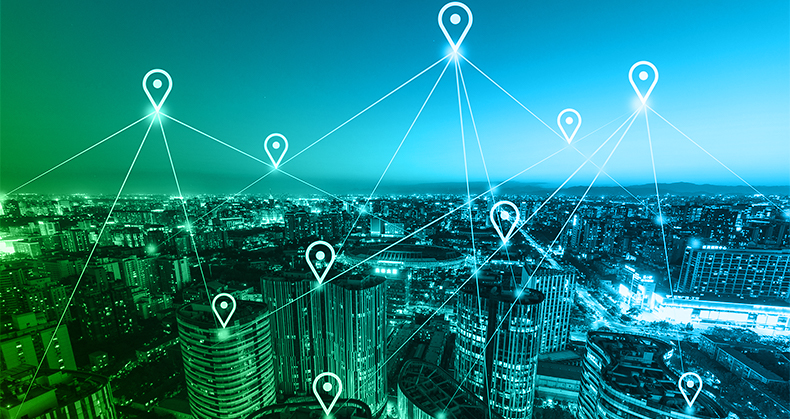MaaS: The Game-Changer To Overcome Our Cities New Challenges

The hub-and-spoke model first appeared during the Renaissance, in Europe, with the advent of absolute monarchy. The purpose of this form was to concentrate all the powers within a hub, with radial streets serving as the spokes. Political, military, spiritual, and economic institutions were centralized, surrounded by mostly residential areas. Despite changes over time, the urban forms remained, forming the very identity of a city.
Transportation was evolving alongside these urban forms and changing with trends and policies through the years. As a result, hub-and-spoke transportation networks emerged to link the heart of the city to its surroundings.
In the 20th century, technological advances and rising living standards influenced the way people travel and the way cities were structured. Cities expanded, sprawling over bigger areas and no longer revolving around a single major pole.
Today, transportation network infrastructure, with its deep roots, still serves as a central link, but major urban highways and boulevards also shape urban forms and the city landscape, often acting as unwanted borders. With population growth and density in urban areas also affecting a city’s housing, sustainability, and social issues, existing infrastructure no longer answers citizens’ needs. The changes in trends and habits and the challenges faced by contemporary cities have revealed that the hub-and-spoke model has reached its limits, and that an inefficient transportation service can accentuate disparities within an area and become a social injustice regarding access to mobility.
Car ownership is decreasing in big cities with extensive public transportation networks, such as Paris, where car ownership dropped from 47.1 percent in 2006 to 35.2 percent in 2016. As millennials and younger generations consider their environmental impact and the cost and convenience of their transportation decisions, they are seeking an optimized experience, regardless of the mode of transportation.
Because of digitalization, innovative solutions in the transportation sector offer many commuting options, such as on-demand vehicles, car-sharing, bike-sharing, and scooter-sharing, to name a few. With suitable policies, these options can enable intermodality by adding to the public transportation network and offering better levels of customization.
This growing need for personalization seems hardly compatible with global and scalable solutions, but Mobility as a Service (MaaS), a concept that emerged a bit ahead of its time in the early 2000s, fits completely within this new context. An efficient, flexible transportation network using MaaS can encourage further movement from private car ownership to more global solutions.
MaaS uses the centralization of the existing transportation network and enables personalized commute choices for users, thanks to AI.
MaaS allows users to have one centralized virtual platform to plan for and book an intermodal trip with optimum time and price, and it helps make transportation policies more inclusive. For the transportation authorities, MaaS is a useful tool to forecast transportation demand and thus analyze it more effectively. For all stakeholders, MaaS responds to new mobility challenges by integrating stakeholder diversity and making sustainability compatible with economic growth.
The success of MaaS will rely on ambitious public policies and a strategic vision. Urban planning and strategic decisions are essential, as infrastructure and buildings are long-lasting. Considering local political, geographical, and cultural contexts will be essential to ensuring the success of public authorities’ strategies and to facilitating profitable investments. However, for a more sustainable and efficient future, city planning needs to adapt to the changing transportation ecosystem.
New city developments are no longer constrained by the traditional hub and spoke model thanks to newer mobility options. With growing environmental constraints and sanitary issues we are facing, adaptability and agility are becoming a necessity for developing regional tailor-made innovative solutions and to implement and coordinate the measures taken by each city.
The Covid-19 pandemic calls for an important change in the way we commute. What matters first is to reassure commuters on the safety of public transportation. MaaS brings solutions that can help in times of a sanitary crisis:
- Integrating solutions to check the users’ health status, combined with smartphone technology already developed, could provide information for users who were in contact with someone infected. This would provide a “health status” of the transport network in real-time, providing analytics and decision support to the operator.
- It could be used to optimize each user’s trip depending on profile criteria such as his age, travel time the user is ready to spend and the level of social distancing he is ready to accept. MaaS could also propose to the user to replan a trip in order to provide a high social distancing level and minimizing the impact on his schedule. It also facilitates fleet management for the operator.
- Micromobility options provide an optimal solution for short trip and social distancing. According to the trends, commuters are more confident to use these solutions since the end of the lockdown. With micromobility solutions integrated in the MaaS, the transport operator could for example provide the sanitizing status of each micromobility solutions to users and monitor the usage of a particular solution.
Every city is different, and there is no single transportation model that will work everywhere. Because transportation culture and critical decisions when it comes to crisis management vary greatly from one region to another, the ultimate transportation solution will be one that can be customized to fit its intended context. The Covid-19 crisis showed that customizable solutions are more than ever a necessity.